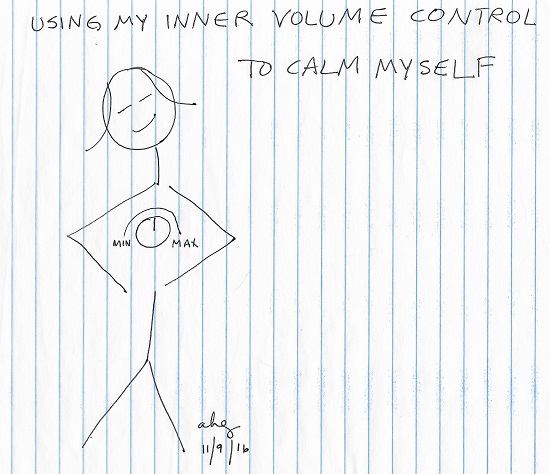If something happened that shocked you, you can help yourself with it.
First, assess whether or not you are currently at risk or may be at risk within the next few minutes. If your situation is unsafe, get yourself to safety as quickly and efficiently as you can.
If you are in a safe enough place for now, hug yourself. Hug yourself hard.
Now. When we’re upset, even for the most legitimate, justifiable reasons, we can’t think. So our job is to “un-upset” ourselves enough to be able to balance feeling and thought so we can use our full powers to discern what would be effective action – or what would be effective inaction – on behalf of ourselves and others.
So. Here we go.
- Acknowledge to yourself that you have had a shock.
- Pause to become aware of your inner experience of the shock. What are you feeling, what are you thinking, what physical sensations are you having?
- Imagine a volume control knob representing the intensity of your inner experience, the totality of your feelings, thoughts, and bodily sensations. On the “minimum” to “maximum” scale, note where the knob registers at this moment.
- Become aware of your breath. Note anything that draws your attention to your breath. Is your breathing rapid or slow? Deep or shallow? Simply notice this.
- Can you deepen, elongate or slow your breath? Even just a bit? If so, you are engaging in an already-in-place, mind-body hack that can begin the “un-upsetting.”
- Now become aware of your thoughts. When you become aware of a thought, imagine the volume control knob and observe what happens when you think the thought.
- If the thought increases the intensity of your inner experience, acknowledge it as a thought to consider later, but for now, for just a few moments, it is not helpful to you as you attempt to shift your inner volume. Disengage your attention from the unhelpful thought and engage your attention with the next thought.
- Simply note the effect of a thought on your inner volume control. Avoid attaching goodness or badness, rightness or wrongness to thoughts. Simply note their effect on you and disengage attention from the unhelpful ones.
- Continue to sort your thoughts, based on their impact on your inner volume control.
- While you’re sorting your thoughts, also monitor your inner volume control.
- Become intentional about using your mind to bring down the volume on your inner experience. There’s no particular how-to on this. How you do this will be unique to you.
- Note that thoughts that are self-judging, other-judging, replay what happened, anticipate future trouble, result in a sense of helplessness, or result in a feeling of outrage or alarm tend to increase the volume on one’s inner experience.
- Appreciate yourself for your fine mind and powerful thinking skills and then shift your attention from these thoughts back to sorting.
- Note your breath. See if you can inhale on a count that works for you, then exhale on the same count.
- Continue to sort thoughts and observe your inner volume control.
Become aware of when you experience the presence of your feelings, thoughts and bodily sensations falling within a manageable range. Then note when your inner volume is moving into an unhelpful range, whether too high or too low, and immediately shift your attention back to sorting unhelpful from helpful thoughts. Use your mind, in your own way, to shift your inner volume to a level that feels manageable to you.
The ability to manage your inner volume frees your inner wisdom – a wise, synergistic blend of both your rationality and emotionality – to help you decide what would be effective, helpful and beneficial for you to do in this moment and the next, no matter what has just happened – or what might or might not.
. . . . .
Maia Szalavitz introduced the idea of using the metaphor of a “volume knob” to represent regulating one’s inner experience in Unbroken Brain: A Revolutionary New Way of Understanding Addiction, published in April, 2016.


